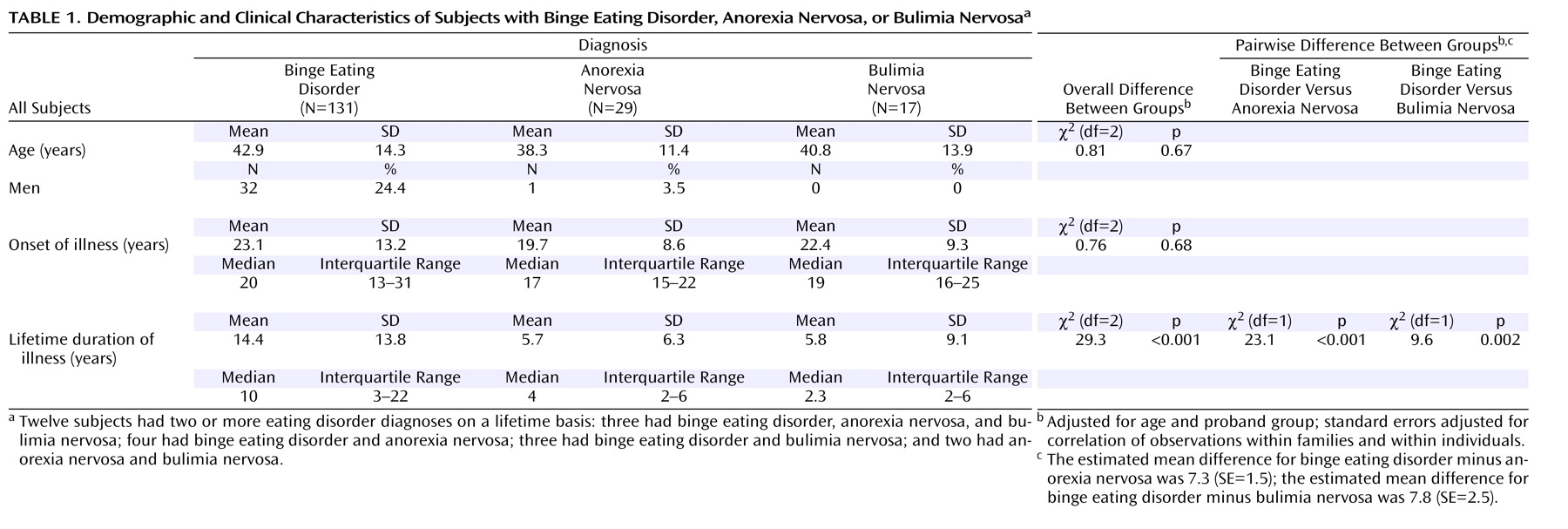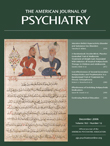Binge eating disorder, a proposed new diagnostic category in DSM-IV, appears more common than the well-established eating disorders anorexia nervosa and bulimia nervosa
(1,
2) . However, some data suggest that binge eating disorder might be a transient and unstable condition in contrast to anorexia nervosa and bulimia nervosa, which are frequently chronic
(3) . For example, Fairburn and colleagues
(4) found that 47 (51%) of 92 community women with bulimia nervosa continued to meet full diagnostic criteria for bulimia nervosa or another eating disorder at 5-year follow-up, whereas only 7 (18%) of 40 women with binge eating disorder showed any clinical eating disorder at 5-year follow-up, and only 4 (10%) still had binge eating disorder. Similarly, Cachelin et al.
(5) found that only 11 (52%) of 21 of community women with binge eating disorder still met full criteria for the disorder at the 6-month follow-up.
However, these studies might have underestimated the chronicity of binge eating disorder because their samples were not entirely representative. For example, in the study by Fairburn et al.
(4), 1) individuals over age 35 were excluded, 2) no men were included, and 3) only 21% of the participants were obese (body mass index ≥30). Similarly, Cachelin et al.
(5) studied only women, and their mean age was 32 years. By contrast, epidemiological data suggest that binge eating disorder frequently affects individuals over age 35, often occurs in men, and is strongly associated with obesity. The McKnight longitudinal study
(6), which included older and more obese participants than the above-mentioned two studies, may thus be more representative; in this investigation, only 7% of the individuals with binge eating disorder had their illness remit after a 1-year follow-up.
To augment these limited and conflicting data, we assessed the duration of binge eating disorder and other eating disorders among individuals personally interviewed during a family study of binge eating disorder.
Method
In a family study, we administered the Structured Clinical Interview for DSM-IV
(7) to overweight or obese probands—150 with lifetime DSM-IV binge eating disorder and 150 with no lifetime eating disorder—who were recruited by advertisement from the community and to 888 of their first-degree relatives ages ≥18 years. All subjects signed informed consent for the study, which was approved by McLean Hospital’s institutional review board after all study procedures had been explained. The primary purpose of this study was to assess the familial aggregation of binge eating disorder
(8) . All participants reporting anorexia nervosa, bulimia nervosa, or binge eating disorder were queried to elicit total lifetime duration of symptoms meeting DSM-IV criteria for these conditions. We departed from DSM-IV only in that 1) we did not require amenorrhea as a criterion for anorexia nervosa, given evidence that this criterion may be superfluous
(9) ; and 2) we excluded cases of anorexia nervosa or bulimia nervosa with durations of less than 6 months because DSM-IV criteria for binge eating disorder require a minimum of 6 months, and we wanted to impose identical minimum duration requirements for all disorders. This latter requirement resulted in the exclusion of two cases of bulimia nervosa but none of anorexia nervosa. We did not analyze the duration of illness in probands because 50% of the probands were selected for binge eating disorder, thus potentially biasing probands toward chronic cases. However, the relatives represented a community sample that was not selected for the presence of binge eating disorder; therefore, we restricted our analysis to relatives.
For our primary analysis, we compared the mean lifetime duration of binge eating disorder with that of anorexia nervosa and bulimia nervosa using regression analyses to control for the relative’s age and the proband group with whom the relative was associated (binge eating disorder or not). We used generalized estimating equations to adjust standard errors for the correlation of observations within families and within individuals (i.e., individuals with more than one eating disorder on a lifetime basis). We performed three additional comparisons while restricting the sample to 1) women; 2) individuals with anorexia nervosa meeting full DSM-IV criteria, including amenorrhea; and 3) relatives of the probands with no lifetime eating disorder.
Results
Relatives with lifetime binge eating disorder, bulimia nervosa, and anorexia nervosa were similar in mean age and age of onset of eating disorders; the group with binge eating disorder contained more men (
Table 1 ). Individuals with binge eating disorder reported a significantly longer mean lifetime duration of illness than those with anorexia nervosa or bulimia nervosa (
Table 1 ). Individuals with all three eating disorders usually reported a single continuous episode of illness, rather than multiple episodes (single episodes in 84.0% of individuals with binge eating disorder, 72.4% for anorexia nervosa, and 64.7% for bulimia nervosa). Restricting analysis to women had little effect on the findings (duration of illness in years: mean=13.0, SD=12.9; mean=5.8, SD=6.3; and mean=5.8, SD=9.1, for binge eating disorder, anorexia nervosa, and bulimia nervosa, respectively). Restricting the definition of anorexia nervosa to include amenorrhea reduced the number of cases to 18, but the mean duration remained virtually unchanged at 5.9 years (SD=7.4). Finally, restricting analysis to the 457 relatives of the probands with no lifetime eating disorder also had little effect (lifetime duration in years: binge eating disorder, mean=14.4, SD=9 [N=44]; anorexia nervosa, mean=6.8, SD=7.2 [N=14]; and bulimia nervosa, mean=2.2, SD=1.0 [N=9] (overall χ
2 =34.9, df=2, p<0.001).
Discussion
Among individuals interviewed in a family study, the mean lifetime duration of binge eating disorder was significantly longer than the two better-established eating disorders: anorexia nervosa and bulimia nervosa. Additionally, most individuals with binge eating disorder reported a single continuous lifetime episode as opposed to multiple episodes. These observations suggest that binge eating disorder is likely a chronic and stable disorder rather than a transient or nonspecific pattern of abnormal eating. Recent findings from a national epidemiologic study point to a similar conclusion
(10) .
Our sample spanned a wider age range than some previous samples
(4,
5) and also was drawn from the community; therefore, it was probably less vulnerable to bias than age-restricted or clinical samples. Nevertheless, it is possible that our sample was biased toward patients with chronic illness because all participants were relatives of overweight or obese probands or because relatives with severe illness might have been more motivated to be interviewed. Also, given our retrospective design, relatives might have erred in their recall and exaggerated the duration or continuity of their illness. However, relatives with current binge eating disorder were only slightly less likely to report a single continuous episode of illness than the group as a whole (76% versus 84%), arguing against the possibility that our results were biased by individuals with past binge eating disorder who retrospectively consolidated multiple episodes into a single episode. In any event, none of these various biases would have influenced our comparison subjects unless they
selectively affected cases of binge eating disorder but not cases of the other eating disorders. Finally, bias might theoretically arise because approximately half of the participants were relatives of a proband with binge eating disorder. However, we found similar lifetime durations of eating disorders when we restricted analysis to relatives of probands with no lifetime eating disorder.
In summary, it appears unlikely that the differences observed in this study are an artifact of bias; prospective studies of representative community samples will be needed to confirm these findings.


